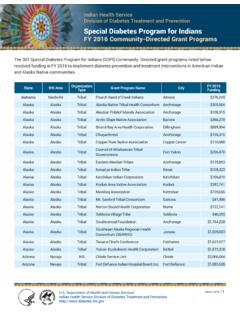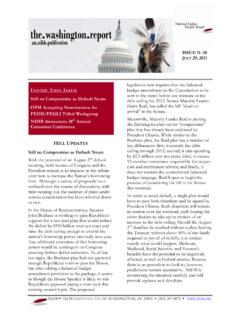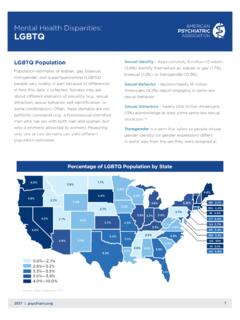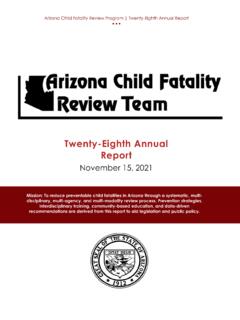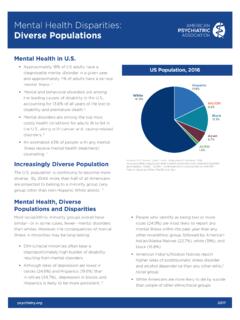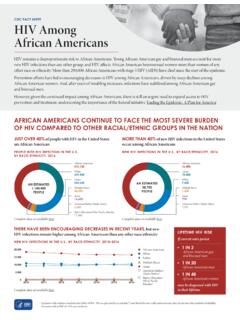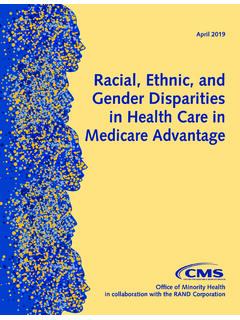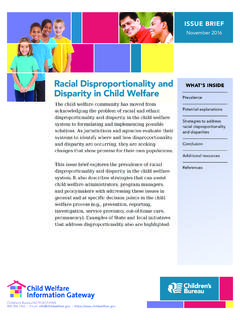Transcription of The Indian Health Delivery System - NIHB
1 The Indian Health Delivery System Federal Health care for american indians and Alaska Natives (AI/AN) is not part of the nation s social welfare program, nor is it insurance. Rather, it is a program founded upon the federal promise to provide Health care services to american indians and Alaska Natives; a federal promise made in treaties, statutes, and authorized by the Constitution. The federal trust responsibility extends to the entire government not just Indian -specific agencies like the Indian Health Service (IHS) or the Bureau of Indian Affairs. Origins of the Federal Trust Responsibility In Cherokee Nation v. Georgia, 30 1 (1831), Chief Justice Marshall noted the special duty the federal government assumed in its dealings and agreements with american indians .
2 Marshall identified Indian Tribes as domestic dependent nations and observed that the relationship between indians and the federal government was like that of a ward to his guardian. In Worchester v. Georgia (1832) the Supreme Court established that the federal government, not states, has the authority over and responsibility for matters relating to members of Indian Tribes. Congress passed the Snyder Act in 1921, providing explicit legislative authorization for federal Health programs for indians by mandating the expenditure of funds for the relief of distress and conservation of Health .. [and] for the employment of .. physicians .. for Indian tribes. More recently, Congress has recognized both that [f]ederal Health services to maintain and improve the Health of the indians are consonant with and required by the Federal Government s historical and unique legal relationship with, and resulting responsibility to, the american Indian people 1 and that it is a major national goal.
3 To provide the resources, processes, and structure that will enable Indian tribes and tribal members to obtain the quantity and quality of Health care services and opportunities that will eradicate the Health disparities between indians and the general population of the United States. 2 The federal trust responsibility and laws enacted provide ample authority for the federal agencies of the Executive Department to design, implement and tailor federal programs in a manner that recognizes and supports the unique government to government relationship between sovereign Tribal governments and the United In 2010, Congress permanently reauthorized the Indian Healthcare Improvement Act declaring that it is the policy of this Nation, in fulfillment of its special trust responsibilities and legal obligations to indians --[] to ensure the highest possible Health status for indians and urban indians and to provide all resources necessary to effect that policy[.]
4 ]4 Indian Health Service One manner in which the federal government partially fulfills its trust responsibility is by making AI/ANs eligible to receive care through the Indian Health Service (IHS) System without charge to the individual Congress created the Indian Health Service in 1955 to provide direct patient care to american indians and Alaska Natives (AI/ANs). Underfunded from the start, IHS continues to provide limited direct care services to million AI/ANs. Today, IHS is a network of over 679 hospitals, clinics, and Health stations located on or near Indian reservations. A little over half of the IHS budget, (56%) goes directly to Tribal communities who operate their own Health systems under contracts and compacts authorized by the Indian Self-Determination and Education Assistance Act (ISDEAA).
5 6 1 25 1601(1). 2 25 1601(2). 3 Additional background on the authority of federal agencies to tailor their programs to meet the unique needs of federally-recognized tribes and american indians and Alaska Natives is provided in Appendix B to the CMS TTAG Strategic Plan, Appendix B: Legal Basis for Special CMS Provisions for american indians and Alaska Natives. A copy of Appendix B is appended to this letter. 4 25 1602 5 42 and 6 These are often called 638 programs in reference to ISDEAA which is 93-638 While programs operated by Tribes directly consistently demonstrate positive results, those Administered by the IHS continue to be plagued by evidence of inadequate patient care, unsafe environments, and lack of medical staff.
6 Recent reports released by the Centers for Medicare and Medicaid Services (CMS) indicate that some IHS-operated facilities are so unsafe that CMS has pulled some hospitals accreditation, and others have closed down emergency services entirely. Chronic funding shortages and agency mismanagement are significant contributors to this crisis. But IHS is just one part of a larger Indian Health System . In order to provide full services to their people, including: disease control and prevention services, long-term care, and other Health services, Tribal communities rely on outside funding from the federal and state governments, in the form of grants, supplemental commercial revenues (if available), and 3rd party collections. This patchwork method of funding means that Tribal Health programs are often varied and face habitual funding challenges just to ensure that basic needs are met.
7 Relationship with the States Indian Tribes are political entities, not interest groups, and not ethnic groups. Indian Tribes are sovereign nations that exist in a government-to-government relationship with the United States, and separate from the state regulatory structure. In fact, Tribes are often competing with state governments for federal funds, despite the unique federal trust responsibility. Tribes are regularly left out of statewide public Health plans and federal funding decisions for public Health programs. Without a local tax base and little (if any) outside funding, Tribal communities are often the most in need of Health dollars. Because of the special trust responsibility between Tribes and the federal government, it is critical that states consult with Tribes in their borders to ensure that the funds they are receiving on behalf of Tribes get allocated appropriately.
8 While some state governments do take into consideration Tribal communities, many do not. Grant Funding Access Tribes and Tribal organizations receive a disproportionately low number of Department of Health and Human Services (HHS) grant awards. american indians and Alaska Natives (AI/ANs) are approximately of the population, but AI/AN entities serving them receive only of total grant funds awarded by HHS agencies. One significant obstacle for Tribes to receive adequate funds for these programs is the fact that block grant funds typically flow directly to states who then must pass funding on to Tribes. Sadly, these funds often do not make it to the Tribal level. In many cases, there is not enough data to even know how widespread the problem is.
9 Unlike state and local governments, Tribes do not have the ability to tax in order to support basic healthcare infrastructure. Therefore, rather than having base funding, Tribal communities must cobble together public Health funding from a variety of federal, state, local, and private funding sources. State governments receive base operational and programmatic funding through the large flagship federal grants, but often Tribes are left out of this process. This leads to rampant unpredictability and inconsistency among Tribal public Health initiatives. Tribes are eligible to apply for many federal grants that address public Health issues, however, many of these programs have little penetration into Indian Country because Tribes have difficulty meeting the service population requirements, match requirements, or are under resourced to even apply for the grants.
10 Unlike state Health departments which employ thousands of people to write grant applications, few Tribes have enough staff to conduct basic programming, let alone work on competitive grant applications. Time for a Change The National Indian Health Board continues to advocate that Tribal communities receive funds directly from the federal government, rather than through states, and receive specific set-aside funding for Health programs administered by IHS. When states are left in charge of disbursing this money to Tribal communities, AI/ANs rarely see those investments reach their communities. It is critical that federal and state governments consult with Tribes to ensure that the needs of AI/ANs are fully understood.

